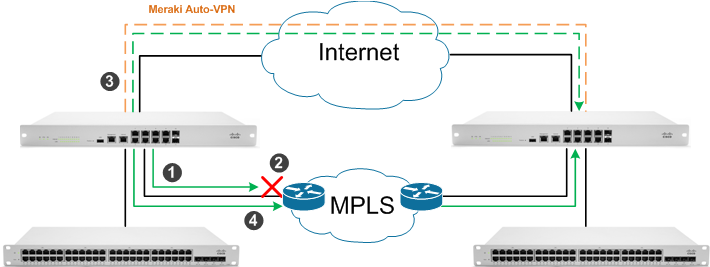Auto VPN Best Practices

In the above diagram, we are utilizing Meraki Auto VPN to connect the enterprise sites inside of China. The above diagram also demonstrates the Chinese approved dedicated circuits connecting the Chinese parts of the enterprise to the rest of the global enterprise. Dynamic routing such as BGP or OSPF can be utilized to exchange routing. Meraki Client VPN uses the Password Authentication Protocol (PAP) to transmit and authenticate credentials. PAP authentication is always transmitted inside an IPsec tunnel between the client device and the MX security appliance using strong encryption. User credentials are never transmitted in clear text over the WAN or the LAN. Whilst you probably know about Meraki Client VPN on the MX, did you know that if you use Systems Manager, you can automatically deploy the VPN configuration.
The best practices listed here focus on the most common deployment scenario, but is not intended to preclude the use of alternative topologies. The recommended SD-WAN architecture for most deployments is as follows:
MX at the datacenter deployed as a one-armed concentrator
Warm spare/High Availability at the datacenter
OSPF route advertisement for scalable upstream connectivity to connected VPN subnets
Datacenter redundancy
Split tunnel VPN from the branches and remote offices
Dual WAN uplinks at all branches and remote offices
Auto VPN at the Branch
Before configuring and building Auto VPN tunnels, there are several configuration steps that should be reviewed.
WAN Interface Configuration

While automatic uplink configuration via DHCP is sufficient in many cases, some deployments may require manual uplink configuration of the MX security appliance at the branch. The procedure for assigning static IP addresses to WAN interfaces can be found in our MX IP assignment documentation.
Some MX models have only one dedicated Internet port and require a LAN port be configured to act as a secondary Internet port via the device local status page if two uplink connections are required. MX models that require reconfiguring a LAN port as a secondary Internet port currently include the MX64 line, MX67 line, and MX100 devices. This can also be verified per-model in our installation guides online. This configuration change can be performed on the device local status page on the Configure tab.
Subnet Configuration
Auto VPN allows for the addition and removal of subnets from the Auto VPN topology with a few clicks. The appropriate subnets should be configured before proceeding with the site-to-site VPN configuration.
Hub Priorities
Hub priority is based on the position of individual hubs in the list from top to bottom. The first hub has the highest priority, the second hub the second highest priority, and so on. Traffic destined for subnets advertised from multiple hubs will be sent to the highest priority hub that a) is advertising the subnet and b) currently has a working VPN connection with the spoke. Traffic to subnets advertised by only one hub is sent directly to that hub.
Configuring Allowed Networks
To allow a particular subnet to communicate across the VPN, locate the local networks section in the Site-to-site VPN page. The list of subnets is populated from the configured local subnets and static routes in the Addressing & VLANs page, as well as the Client VPN subnet if one is configured.
To allow a subnet to use the VPN, set the Use VPN drop-down to yes for that subnet.
:quality(90)/images.vogel.de/vogelonline/bdb/1311000/1311035/original.jpg)

Auto VPN at the Data Center
Deploying a One-Armed Concentrator
A one-armed concentrator is the recommended datacenter design choice for an SD-WAN deployment. The following diagram shows an example of a datacenter topology with a one-armed concentrator:
NAT Traversal
Whether to use Manual or Automatic NAT traversal is an important consideration for the VPN concentrator.
Use manual NAT traversal when:
There is an unfriendly NAT upstream
Stringent firewall rules are in place to control what traffic is allowed to ingress or egress the datacenter
It is important to know which port remote sites will use to communicate with the VPN concentrator
If manual NAT traversal is selected, it is highly recommended that the VPN concentrator be assigned a static IP address. Manual NAT traversal is intended for configurations when all traffic for a specified port can be forward to the VPN concentrator.
Use automatic NAT traversal when:
Cisco Meraki Vpn Troubleshooting
None of the conditions listed above that would require manual NAT traversal exist
Cisco Meraki Prices
If automatic NAT traversal is selected, the MX will automatically select a high numbered UDP port to source Auto VPN traffic from. The VPN concentrator will reach out to the remote sites using this port, creating a stateful flow mapping in the upstream firewall that will also allow traffic initiated from the remote side through to the VPN concentrator without the need for a separate inbound firewall rule.
